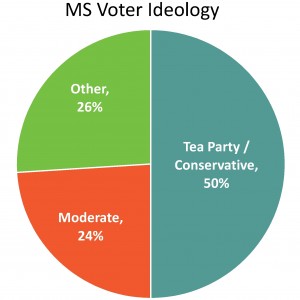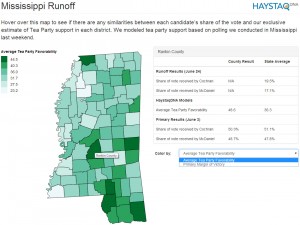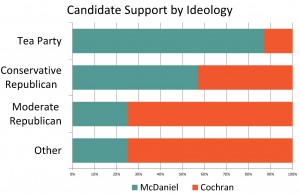For a dynamic map of runoff results see: http://viz.hays
Month: June 2014
Mississippi Runoff: Getting Ready for the Polls to Close
Interest in the race is high. In a large-sample survey of 6,381 registered Mississippi voters conducted by HaystaqDNA over the weekend, 67% said that they will definitely vote in the runoff election. As one would expect, self-reported turnout likelihood is highest among voters who have a declared preference in the runoff, with 90% of Cochran supporters and 94% of McDaniel supporters saying that they will definitely vote.
There is a stark ideological divide in the race, with self-identified Tea Party or conservative Republicans being much more likely to support McDaniel.
Ideology McDaniel Cochran
Tea Party………………………………..87% 13%
Conservative Republican……………..57% 43%
Moderate Republican………………….25% 75%
Other…………………………………….25% 75%
Among all groups of self-identified Tea Party or Republican voters, more than 90% claim that they will definitely vote. Among other voters, the Democrats or independents who Cochran is reported to be courting, self-reported turnout likelihood is lower, but still almost 80%
Ideology Definitely Vote
Tea Party……………………………….91%
Conservative Republican……………..93%
Moderate Republican…………………93%
Other……………………………………79%
Mississippi Runoff: What to Expect
 Although we’re still crunching the numbers from this weekend’s surveys, a few interesting observations stand out:
Although we’re still crunching the numbers from this weekend’s surveys, a few interesting observations stand out:
- More than 50% of Mississippi voters described themselves as conservative or Tea Party Republicans, compared to only 24% who described themselves as Moderate Republicans.
- McDaniel voters are much more likely than Cochran voters to say that they want to send a message with their vote as opposed to just voting for their candidate of choice.
- Voters are fairly evenly split about whether they want a senator who can reach across the aisle and break gridlock or one who will stand firm on political principles.
- Voters are also split on whether Cochran’s long tenure in the Senate is an asset or a liability.
- And, finally, more than 75% of Mississippi voters say that they have paid some or a great deal of attention to news coverage of Eric Cantor’s surprise loss in VA.
Ken Strasma is CEO and Co-founder of HaystaqDNA
VA-7: Is David Brat Squandering his Opportunity?
I’m fortunate enough to live in the 7th Congressional District of Virginia, so I’m right in the middle of all the coverage of one of the biggest stories in domestic politics right now. One of the big stories has been the silence of David Brat for almost a week (as of the time I write this post) after his win. The nation was focused on him and his district, and it was a great chance for him to introduce himself to potential voters. But still we’ve heard nothing from the Republican nominee.
The recent work in political science argues that even presidents are unable to move public opinion through making speeches, and this has begun to infiltrate media accounts of presidential power as well.* However, what we haven’t been able to examine is the counterfactual to a president speaking. We’ve been missing the proverbial “dog that didn’t bark.” We now have a great example of this, as we see the Republican nominee avoiding media attention after his upset victory. David Brat’s lack of public presence in VA-07 after winning the primary shows us exactly the costs of failing to speak and failing to be prepared. Nowhere is this more evident than on reporter Parker Slaybaugh’s Facebook feed where he posted:
I have tried for 2 days now to speak with Dave Brat after his victory over Eric Cantor and he and his campaign have told me he is not speaking at all publicly until maybe Monday. They say they are bring on more staff to help out. What do you think? Do you think he should have spoken to his constituents and to the media by now? Let me know in the comments below!
While clearly looks like the Facebook equivalent of a push poll, many of the commenters agreed strongly with the premise of this post. Cantor had been voted out in part because of his failure to connect with the district, so Brat’s initial post-victory silence may have soured voters against him. While media appearances might not have helped his standing in the district, failing to appear certainly seems to be hurting him, at least in the short-term.
This is a great example of where randomized experiments, the type preferred by political scientists and considered the gold standard in the academic literature on campaigns, can’t help us understand politics. No candidate is going to let us randomly decide whether he will be available to the press after the campaign, nor is any president. But we don’t want to let the availability of experiments limit the types of questions we can answer and what we can learn about politics. So we have to look for natural experiments, where a candidate is “assigned” to a treatment condition through factors outside his control. Brat’s unexpected win is a great example of a candidate being caught unprepared and forced to react, and offers us a great chance to learn the costs of a candidate not going public.
Chad Murphy
Fellow – HaystaqDNA
Assistant Professor of Political Science – University of Mary Washington
——————————
*For a counterpoint to this line of work, see my work with former student Annie Morris showing that presidents are able to change the behavior of members of Congress.
Cantor Threats Were Evident
I have been a resident of VA-07 since the 2010 round of redistricting, so I’ve experienced a couple of Congressman Cantor’s campaigns firsthand. Back in 2012, Cantor barely campaigned. The campaign was so low-key that several of my neighbors still displayed “Wittman for Congress” signs in their yards , presumably leftover from 2010, as they were unaware that we were redrawn into Cantor’s district. These are people passionate enough about voting that they kept yard signs in their garages for at least two years and then put them back out in 2012, but, presumably, they didn’t know they were represented by Eric Cantor until they got to the polling place. It would have been easy to miss− other than a couple of negative postcards about his opponent, there didn’t seem to be much of a campaign at all.
Fast-forward to 2014 and we saw a flood of TV ads describing David Brat as a “liberal college professor” and “advisor to Tim Kaine” (both of which are claims of dubious truthfulness). We saw ads that looked like a negative ad from Barack Obama against Eric Cantor, describing the latter as someone who wouldn’t compromise and would stick to his conservative values. But more telling was the fact that interest groups were getting involved in the campaign on behalf of Cantor. According to a tweet from Derek Willis, reporter for the NY Times Upshot, “The $308k American Chemistry Council spent on ad backing Eric Cantor is 29x all other IEs in his district since 2006 combined.” They were running TV spots as frequently, if not more frequently, than the Congressman himself. These ads were polished, well-done, and professional. Clearly someone had spent a lot of money on these ads, but why?
According to the internal polls his campaign released, Cantor was up by 34 points. This made sense to much of the media because everyone expected him to win easily, so no one gave it any more thought. Something didn’t add up though. If Cantor was winning by 34 points, why would he be spending so much money in the primary? Why would the American Chemistry Council be spending so much of their money to help a candidate who was clearly going to win? Why not devote their resources elsewhere? The answer was simple: because everyone involved with the campaign knew that the poll was wrong and that David Brat posed a real threat to the incumbent’s position. As I posted back on May 22, Cantor was worried about being outflanked by the Tea Party.
We know that candidates always project an optimistic front, strategically releasing internal polls for a variety of reasons unrelated to sharing true predictions. So you can’t rely on their words to know what they’re thinking, you can only rely on their actions to signal how they truly see their chances. If they are running more ads than normal, they think they are losing. If those ads are negative, they think they are losing. Even acknowledging the opponent is a signal that candidates see that opponent as a viable challenge. Cantor’s campaign definitely did that through the deluge of ads both by the campaign and the American Chemistry Council. The signals were there, you just had to know where to look.
Chad Murphy
Fellow – HaystaqDNA
Assistant Professor, Political Science – University of Mary Washington
Haystaq’s Ken Strasma on MSNBC
Watch Haystaq Co-founder Ken Strasma break down the impact of Tea Party enthusiasm, as illustrated in Tuesday night’s defeat of House Majority Leader Eric Cantor, on the 2014 mid-terms, on MSNBC’s “The Last Word”.
Reading Into Book Sales
A recent flurry of press attention to the suggestion that Secretary Clinton could use data from her upcoming book tour to aid her presidential campaign caught our attention.
Ultimately, Simon & Schuster said that Clinton would “unequivocally” not have access to data they’re collecting.
But if she does decide to run, that data could be extremely useful, if used in the right way.
It used to be that you could tell a lot about a person by what they kept on their bookshelves. Today, even with the proliferation of electronic publishing, we can still use what people choose to read in their spare time as a lens to predict their voting behavior. You still can’t judge an e-book by its cover, but you can learn a lot from the patterns of the people buying it.
As a general rule, organizations should be collecting data on every interaction they have with people, in every channel. Whether they are ready to put it to use today, or planning for a potential future.
When it comes to book purchases, retailers will never release the individual data they collect on purchases. (And this is probably a good thing.) However, it is certainly feasible to release sales data by small units of geography, like county or ZIP code – either publicly, or to publishers and authors. This data would be incredibly useful for directly targeting or modeling support at a geographic level, particularly in instances where we can identify specific books which closely track voter’s expressed preferences and likely behavior.
Specific titles can provide a lot of insight into expected behavior all across the political spectrum:
Examples from current best-seller lists: Thomas Piketty’s “Capital in the 21st Century” / Elizabeth Warren’s “A Fighting Chance” / Ben Carson’s “One Nation” / Tim Geithner’s “Stress Test” / Arianna Huffington’s “Thrive: The Third Metric” / Sheryl Sandberg’s “Lean In”.
On the individual level, we can predict with a fair degree of certainty how a buyer of any of these books might vote. But people buy books for lots of reasons, and we caution against making the mistake of directly imputing a political bent to a reader who might pick up a book simply for reasons other than to satiate their ideological views.
But, in the aggregate, we can use purchases of certain titles to contribute to predicting expected voting outcomes at the individual, group and geographic levels.
In the 2008 and 2012 general elections, campaigns had a very basic sense of this dynamic, as book releases by candidates like President Barack Obama’s best-selling “The Audacity of Hope” and Senator Rick Santorum’s “It Takes a Family” set the stage for political movements. But the e-book industry was then a mere fraction of what it is today.
With the 2014 midterms around the corner, and the 2016 presidential primary season to follow soon on its heels, to get a sense of where their prospective voters’ hearts are leaning, smart campaigns will be wise to consider their potential supporters’ bookshelves in addition to their voting behavior.
Michael Simon is President and co-founder of HaystaqDNA. In 2008, he ran the in-house Obama for America analytics department.
What should Democrats and the GOP be hoping for in today’s Primaries?
Establishment Republicans have been beating back Tea Party challengers in recent primaries. Both factions can make an electability argument. Tea Party candidates rightly point out that their base is more enthusiastic than the rest of the electorate, while mainstream Republicans correctly argue that the Tea Party is turning off swing voters.
Both these arguments appear to be correct. In a survey of Iowa voters that we conducted last night:
- 68% of strong Tea Party supporters said that they were more enthusiastic about voting than they were in previous years.
- This compares to 42% of the population at large, and only 35% of those strongly opposed to the Tea Party saying that they were more enthusiastic about voting .
- 90% of strong Tea Party supporters say that they will definitely vote, compared to 71% of voters at-large.
- Voters consistently over-state their likelihood to vote, but at least in terms of self-reported turnout likelihood, Tea Party supporters have a 19% advantage.
On the other hand, among voters who routinely spit their tickets, 54% say that they would be less likely to support the Republican candidate if that candidate had close ties to the Tea Party, while only 11% of the ticket splitters said that they were more likely to support a candidate associated with the Tea Party.
So how do you weigh these two factors? Does the increased enthusiasm of Tea Party supporters make up for the swing voters they will turn off? It’s hard to say, but it’s fun to do some back-of-the-envelope math. The strong Tea Party supporters account for 18% of the electorate in Iowa. Ticket splitters account for 26%. According to this survey, strong Tea Party voters are 19% more likely than voters at large to say that they will definitely vote. So this translates into a 3.4% bump that can be attributed to increased enthusiasm among Tea Party backers. Of course many of those would vote for the Republican candidate whether or not that candidate had close ties to the Tea Party, so it is impossible to say how many of those 3.4% would be net new votes.
Ticket splitters make up 26% of the population, and 54% of them say that they are less likely to vote for a candidate associated with the Tea Party. 11% say that they are more likely to vote for a Tea Party candidate, so that translates into a net minus of 43% in support among the ticket splitters. 43% of a group that comprises 26% of the electorate gives us an 11% decrease in support for the Republican candidate if Republicans nominate someone with close ties to the Tea Party.
These two calculations aren’t apples to apples. As noted earlier, self-reported turnout likelihood is notoriously unreliable, and as for the swing voters we don’t know how many of them would not have voted for the Republican candidate in any circumstances. Still, the large difference between the two numbers does seem to indicate that Republican operatives should be hoping for wins by mainstream Republicans in tonight’s primaries.
Democrats can just breathe a sigh of relief that for once they aren’t the ones with the bitter inter-party fight.

